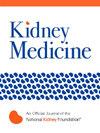Galectin-3 Is Associated With Risk of Cardiovascular and Kidney Outcomes in Ambulatory Veterans
IF 3.4
Q1 UROLOGY & NEPHROLOGY
引用次数: 0
Abstract
Rationale & Objective
Cardiovascular and kidney disease are highly prevalent comorbid conditions, and each is a risk factor for the other condition. We evaluated whether Galectin-3 (Gal-3), a biomarker of organ fibrosis, is associated with cardiovascular and kidney events in ambulatory Veterans.
Study Design
An observational cohort study.
Setting & Participants
Ambulatory Veterans presenting for an outpatient echocardiogram at the San Diego Veterans Affairs between 2010 and 2013.
Predictor
Blood Gal-3 levels.
Outcomes
The primary cardiovascular outcome was major adverse cardiac events (MACEs: acute coronary syndrome [ACS], stroke, heart failure [HF] hospitalization, or cardiovascular death). The primary kidney outcome was major adverse kidney events (MAKEs: ≥40% estimated glomerular filtration rate decrease or renal replacement therapy). Secondary outcomes were cardiovascular death, incident HF, ACS, and all-cause mortality.
Analytical Approach
Cox proportional hazard models adjusting for cardiovascular and kidney disease risk factors.
Results
A total of 882 Veterans with an average age of 66 ± 12 years, 97% were men, average eGFR of 78 ± 20 mL/min/1.73 m2, 40% prevalence of coronary artery disease, and 17% prevalence of HF. Higher Gal-3 was associated with a greater risk of MACEs (hazard ratio [HR], 1.54 per 2-fold higher Gal-3; 95% confidence interval [CI], 1.02-2.32; P = 0.04), cardiovascular death (HR, 3.41; 95% CI, 1.75-6.66; P < 0.001), and all-cause mortality (HR, 1.81; 95% CI, 1.41-2.33; P < 0.001), but not incident HF or ACS. Higher Gal-3 was associated with a greater risk of MAKEs (HR, 1.92; 95% CI, 1.20-3.08; P = 0.004). Higher Gal-3 was associated with >350% greater risk of experiencing both MACEs and MAKEs during follow-up (HR, 3.57; 95% CI, 1.63-7.84; P = 0.002).
Limitations
Select population of Veterans presenting for an echocardiogram who were primarily older men with multiple comorbid conditions.
Conclusions
Gal-3 is associated with risk of cardiovascular and kidney outcomes among ambulatory Veterans.
Plain Language Summary
Galectin-3 is a biomarker of organ fibrosis and has been associated with risk of cardiovascular and kidney outcomes individually, but its association with both outcomes is less well described. We assessed whether Galectin-3 was associated with risk of cardiovascular and kidney events in 882 ambulatory Veterans with 13 years of follow-up. We found that Galectin-3 was associated with risk for major adverse cardiac events (acute coronary syndrome, stroke, cardiovascular death, or heart failure hospitalization) and major kidney events (need for renal replacement therapy or ≥40% decrease in estimated glomerular filtration rate), even when adjusting for cardiovascular and kidney disease risk factors. These findings suggest Galectin-3 may help identify individuals at risk for cardiovascular and kidney events earlier.
半乳糖凝集素-3与门诊退伍军人心血管和肾脏预后风险相关
理由和目的心血管和肾脏疾病是非常普遍的合并症,每一种疾病都是另一种疾病的危险因素。我们评估了半乳糖凝集素-3 (Gal-3),一种器官纤维化的生物标志物,是否与流动退伍军人的心血管和肾脏事件相关。研究设计:观察性队列研究。背景和参与者:2010年至2013年间,在圣地亚哥退伍军人事务部接受门诊超声心动图检查的退伍军人。预测血Gal-3水平。主要心血管结局为主要心脏不良事件(mace:急性冠状动脉综合征(ACS)、中风、心力衰竭(HF)住院或心血管死亡)。肾脏的主要结局是主要的肾脏不良事件(估计肾小球滤过率降低≥40%或肾脏替代治疗)。次要结局是心血管死亡、心衰事件、ACS和全因死亡率。分析方法cox比例风险模型调整心血管和肾脏疾病的危险因素。结果退伍军人882例,平均年龄66±12岁,男性占97%,平均eGFR 78±20 mL/min/1.73 m2,冠心病患病率40%,心衰患病率17%。较高的Gal-3与较高的mace(风险比[HR], 1.54 / 2倍高的Gal-3; 95%可信区间[CI], 1.02-2.32; P = 0.04)、心血管死亡(HR, 3.41; 95% CI, 1.75-6.66; P < 0.001)和全因死亡率(HR, 1.81; 95% CI, 1.41-2.33; P < 0.001)相关,但与HF或ACS事件无关。较高的Gal-3与较高的make风险相关(HR, 1.92; 95% CI, 1.20-3.08; P = 0.004)。高Gal-3与随访期间发生mace和make的风险增加350%相关(HR, 3.57; 95% CI, 1.63-7.84; P = 0.002)。局限性:选择接受超声心动图检查的退伍军人人群,主要是有多种合并症的老年男性。结论sgal -3与门诊退伍军人心血管和肾脏预后风险相关。半乳糖凝集素-3是一种器官纤维化的生物标志物,与心血管和肾脏结局的风险单独相关,但其与这两种结局的关系尚不清楚。我们对882名退伍军人进行了13年的随访,评估了半乳糖凝集素-3是否与心血管和肾脏事件的风险相关。我们发现半乳糖凝集素-3与主要不良心脏事件(急性冠状动脉综合征、中风、心血管死亡或心力衰竭住院)和主要肾脏事件(需要肾脏替代治疗或估计肾小球滤过率降低≥40%)的风险相关,即使在调整心血管和肾脏疾病危险因素时也是如此。这些发现表明半乳糖凝集素-3可能有助于更早地识别有心血管和肾脏疾病风险的个体。
本文章由计算机程序翻译,如有差异,请以英文原文为准。
求助全文
约1分钟内获得全文
求助全文

 求助内容:
求助内容: 应助结果提醒方式:
应助结果提醒方式:


